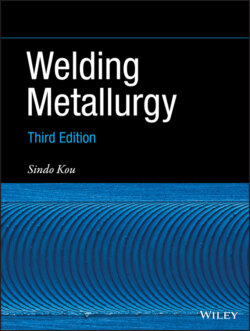Читать книгу Welding Metallurgy - Sindo Kou - Страница 61
Problems
Оглавление1 11.1 It has been suggested that compared to SMAW, the cooling rate is higher in GMAW and it is, therefore, more likely for heat‐affected zone cracking to occur in hardenable steels. What is the main reason for the cooling rate to be higher in GMAW than SMAW?
2 11.2 The diameter of the electrodes to be used in SMAW depends on factors such as the workpiece thickness, the welding position, and the joint design. Large electrodes, with their corresponding high currents, tend to produce large weld pools. When welding in the overhead or vertical position, should you use larger or smaller electrodes?
3 11.3 In GTAW the welding cable is connected to the tungsten electrode through a water‐cooled copper contact tube, as shown in Figure 1.12. Why is the tube positioned near the lower end of the electrode instead of the top?
4 11.4 Measurements of the axial temperature distribution along the GTAW electrode have shown that the temperature drops sharply from the electrode tip toward the contact tube. Why? For instance, with a 2.4‐mm‐diameter W–ThO2 electrode at 150 A, the temperature drops from about 3600 K at the tip to about 2000 K at 5 mm above the tip. Under the same condition but with a W‐La2O3 electrode, the temperature drops from about 2700 K at the tip to about 1800 K at 5 mm above the tip [30]. Which electrode can carry more current before melting, and why?
5 11.5 Experimental results show that in EBW the penetration depth of the weld decreases as the welding speed increases. Explain why. Under the same power and welding speed, do you expect a much greater penetration depth in aluminum or steel, and why?
6 11.6 How does the working distance in EBW affect the depth–width ratio of the resultant weld?
7 11.7 Consider EBW in the presence of a gas environment. Under the same power and welding speed, rank and explain the weld penetration for Ar, He, and air. The specific gravities of Ar, He, and air with respect to air are 1.38, 0.137, and 1, respectively, at 1 atm, 0 °C.
8 11.8 Which arc welding process could have been used for joining the edge weld of thin‐gauge steel shown in Figure P1.8, and why?Figure P1.8 Edge weld of thin‐gauge steel.
9 11.9 Two 15‐cm‐thick steel plates were joined together in a single pass, as shown in Figure P1.9. Which welding process could have been used, and why? Figure P1.9 Steel plates were joined together in a single pass.
10 11.10 Consider the four typical welding positions. (a) Which position is the easiest in butt welding of plates? (b) Which position is the hardest in butt welding of plates? (c) In butt welding of two steel pipes in the construction of a long‐distance oil pipeline, which welding positions are involved?
11 11.11 Electrodes exposed to air must be baked at 250 °C for 30 minutes to drive out moisture before welding. (a) Which type of electrodes does this procedure apply to? (b) Why?
12 11.12 It was reported that the first covered electrode for SMAW, developed by A. O. Smith Corporation in Milwaukee, was a steel wire spirally wrapped with paper soaked in liquid sodium silicate, a binder, and then baked. It produced an effective gas shield to protect the liquid steel and improved the weld‐metal ductility significantly. What type of electrode covering was this?
13 11.13 Decomposition in air starts at about 545 °C for CaCO3, 325 °C for MgCO3, and 220–250 °C for organic gas formers. (a) If a covered electrode needs to be baked before welding, why should it be kept below a maximum baking temperature? (b) Which material should be baked at a maximum of 150 °C for an electrode covering? (c) What about at 300 °C? (d) What about 450 °C?
14 11.14 Consider butt welding of two horizontal pipes in the circumferential direction by SAW, as shown in Figure P1.14. Suppose the pipe wall is thick, so the molten weld pool and slag are large and long and tend to run away. (a) Suppose the electrode is at position A. Sketch the molten weld pool. (b) Should the electrode position be changed to B or C in order to minimize the problem? Hint: Moving the workpiece in one direction under a stationary arc is equivalent to moving the arc in the opposite direction over a stationary workpiece.Figure P1.14 SAW butt welding of two horizontal pipes.
